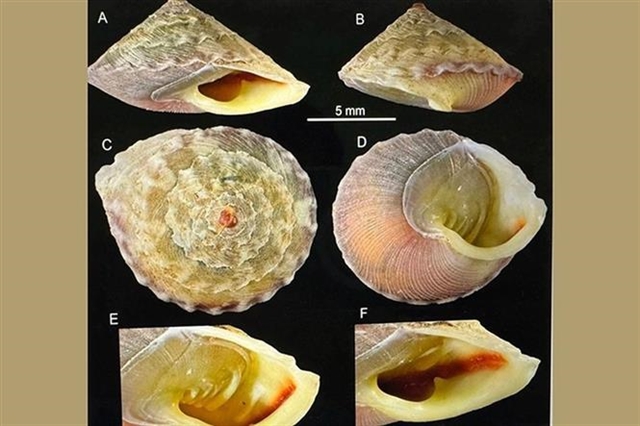 Environment
Environment

 |
| “Ốc nón Sơn Đoòng” (Sơn Đoòng cone snail) is first recorded species of land gastropods in Việt Nam. —VNA/VNS Photos |
HÀ NỘI — Vietnamese scientists have discovered a new snail species in Sơn Đoòng Cave within the Phong Nha - Kẻ Bàng National Park in the central province of Quảng Bình, and named it “Ốc nón Sơn Đoòng” (Sơn Đoòng cone snail).
This land snail species, scientifically called Calybium plicatus sp. nov., belongs to the Calybium genus, the Helicinidae family, the Cycloneritida order, and the Gastropoda class, within the Animalia kingdom.
It was found during a state-level project to research biodiversity in the Sơn Đoòng Cave system for conservation and sustainable development implemented by the Việt Nam Museum of Nature under the Việt Nam Academy of Science and Technology.
Associate Professor Dr. Vũ Văn Liên, Deputy General Director of museum and the project leader, said that Calybium plicatus sp. nov. has a shell resembling that of Calybium massiei Morlet, 1892, but it is smaller in size and has six evenly spaced top plates on the apex. This discovery marks the first recorded species of land gastropods in Việt Nam.
 |
| Vietnamese scientists have discovered a new snail species in Sơn Đoòng Cave |
The research results on the new species have been published in the Ruthenica Journal, Volume 35, Issue 1 (2025), enhancing the scientific value and international attention on the unique ecosystem of the Phong Nha - Kẻ Bàng National Park, said Dr. Liên.
Phạm Hồng Thái, Director of the park's Management Board, praised the research, noting that it provides crucial scientific contributions that will help the park manage and protect Sơn Đoòng Cave and surrounding caves sustainably. The project has also created a comprehensive biodiversity database for the Sơn Đoòng Cave system and surrounding areas, reinforcing the park's global significance not only in geological and scenic terms but also in biodiversity and unique aesthetic values, he added.
Sơn Đoòng Cave, located in the Phong Nha - Kẻ Bàng forest in Quảng Bình, was first discovered by a local resident in 1990. In 2009, it was explored and confirmed by the British Cave Research Association as the largest cave in the world. Since its discovery, Sơn Đoòng has captivated the world with its enormous size and unique cave formations that are unmatched anywhere.
The Phong Nha - Kẻ Bàng National Park currently records 2,954 species of higher plants, belonging to 1,007 genera, 198 families, 63 orders, 12 classes, and six phyla, including 111 species in Việt Nam's Red Data Book of Threatened Species, and 121 in International Union for Conservation of Nature (IUCN) Red List. It also records 1,399 animal species from 835 genera, 289 families, 66 orders, 12 classes, and four phyla, including 82 species in Việt Nam's Red Data Book and 116 in the IUCN Red List. — VNS




